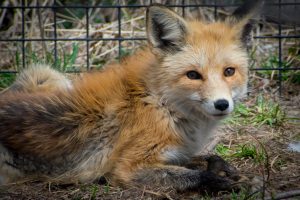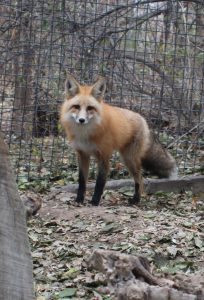Red Fox (Vulpes vulpes)
Taxonomy
Kingdom: Animalia
Phylum: Chordata
Class: Mammalia
Order: Carnivora
Suborder: Caniformia
Family: Canidae
Genus: Vulpes
Species: Vulpes vulpes
Conservation Status in Idaho
Least concern
Range and Habitat
The red fox has the widest distribution of any canid found throughout much of the northern hemisphere from the Arctic Circle to Central America. They occupy a wide range of habitat including forest, tundra, prairie, desert, mountains, farmlands, and urban areas. Red fox however prefer mixed vegetation communities such as edge habitats, mixed scrub, and woodland areas.
Physical Features
Weight: 6.5–31.0 lbs (3–14 kg)
Length: 1.5–3.0 ft (4.55–90.0 cm)
Tail: 12.0–22.0 in (30–55.5 cm)
Red fox are the largest of the Vulpes species. Coloration ranges from pale yellowish red to deep reddish brown dorsally to white or ashy on the ventral side. The lower part of the legs is usually black and the tail has a white or black tip. Two color variants commonly occur. Cross foxes have reddish brown fur with a black stripe down the back and another across the shoulders. Silver foxes range from strong silver to nearly black and are the most prized by furriers. These variants are about 25% and 10% of red fox individuals, respectively.
Diet
Omnivores that mostly eat rodents, rabbits, insects, and fruit. Occasionally red fox will eat carrion.
Lifespan
Red fox may live up to three years in the wild and 10-12 years in captivity.
Reproduction
Red fox mating behavior varies substantially. Often males and females are monogamous, but males with multiple female mates are also known, as are male/female pairs that use non-breeding female helpers in raising their young. Females mated to the same male fox may share a den. Red fox groups always have only one breeding male, but that male may also seek mating outside of the group. Breeding season depending on location varies from December-April. Gestation is 49-55 days with 1-9 kits being born. Kits are weened between 56-70 days and reach sexual maturity by 10 months of age.
Social Behavior and Interaction
Red foxes are solitary animals that do not form packs like wolves. They are partially territorial with adjacent ranges overlapping somewhat and other areas within the range regularly defended. Individuals and family groups live in dens which are usually old rabbit, marmot, woodchuck burrows. The same den is often used over a number of generations. Red foxes are terrestrial and either nocturnal or crepuscular (active during dawn and dusk).
Major Threats
Threats are highly localized and include habitat fragmentation and degradation, exploitation, and persecution.


